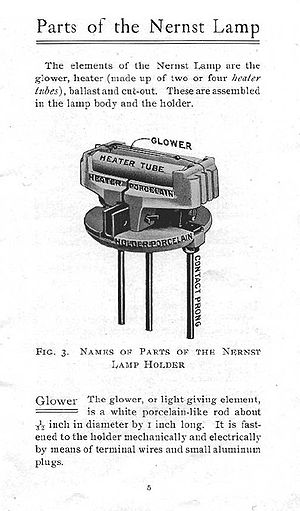- Nernst lamp
-
 Nernst lamp, complete, model B with cloche, DC-lamp 0.5 ampere, 95 volts, by courtesy of Landesmuseum für Technik und Arbeit in Mannheim, Germany, (Engl.: State Museum of Technology and Labour, Mannheim)
Nernst lamp, complete, model B with cloche, DC-lamp 0.5 ampere, 95 volts, by courtesy of Landesmuseum für Technik und Arbeit in Mannheim, Germany, (Engl.: State Museum of Technology and Labour, Mannheim)
Nernst lamps were an early form of electrically powered incandescent lamps. Nernst lamps did not use a glowing tungsten filament. Instead, they used a ceramic rod that was heated to incandescence. Because the rod (unlike tungsten wire) would not further oxidize when exposed to air, there was no need to enclose it within a vacuum or noble gas environment; the burners in Nernst lamps could operate exposed to the air and were only enclosed in glass to isolate the hot incandescent emitter from its environment. A ceramic of zirconium oxide - yttrium oxide was used as the glowing rod.
Developed by the German physicist and chemist Walther Nernst in 1897 at Goettingen University, these lamps were about twice as efficient as carbon filament lamps and they emitted a more "natural" light (more similar in spectrum to daylight). The lamps were quite successfully marketed for a time, although they eventually lost out to the more-efficient tungsten filament incandescent light bulb. One disadvantage of the Nernst design was that the ceramic rod was not electrically conductive at room temperature so the lamps needed a separate heater filament to heat the ceramic hot enough to begin conducting electricity on its own.
In the U.S., Nernst sold the patent to George Westinghouse who founded the Nernst Lamp Company at Pittsburgh in 1901. Minerals for the production of the glowers were extracted from the company's own mines at the legendary Barringer Hill, Texas (since 1937 buried beneath the waters of Lake Buchanan). By 1904 a total of over 130,000 Nernst lamps had been placed in service throughout the country.
In Europe the lamps were produced by the German Allgemeine Elektrizitäts-Gesellschaft (AEG, General Electricity Company) at Berlin. At the World's Fair 1900 at Paris the pavilion of the AEG was illuminated by 800 Nernst lamps which was quite spectacular at that time.
In addition to their usage for ordinary electric illumination, Nernst lamps were used in one of the first practical long-distance photoelectric facsimile (fax) systems, designed by professor Arthur Korn in 1902, in Allvar Gullstrand's slit lamp (1911) for ophthalmology, for projection and in microscopy.
After Nernst lamps fell into obsolescence the term "Nernst glower" went on to be used to describe the infrared-emitting source used in IR spectroscopy devices. (Recently, even this term has become obsolete as Nernst glowers have been largely replaced for this purpose by silicon carbide glow bars or "globars" [1] which are conductive even at room temperature and therefore need no preheating.)
See also
- Globar, a silicon carbide rod used as thermal light source for infrared spectroscopy
- List of light sources
External links
Lamps and lighting Incandescent Fluorescent High-intensity
discharge (HID)Mercury-vapor · Hydrargyrum medium-arc iodide (HMI) · Hydrargyrum quartz iodide (HQI) · Metal halide (Ceramic) · Sodium vaporGas discharge Deuterium arc · Neon · Sulfur · Xenon arc / Xenon flash · Black light · Tanning lamp · Germicidal · Growth lightElectric arc Combustion Other Lamp (electrical component) · Light fixture · Lightbulb sockets · Light-emitting diode (LED) · LED lamp · Solid-state (SSL) · Plasma · Electroluminescent wire · Chemiluminescence · Radioluminescence · Glow stick · ESLCategories:- Incandescent light bulbs
Wikimedia Foundation. 2010.

